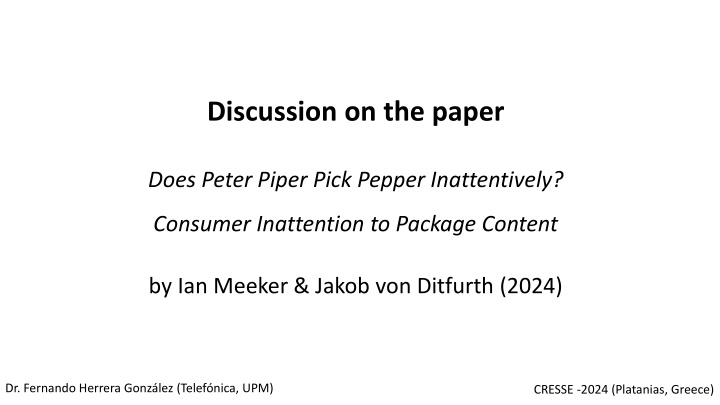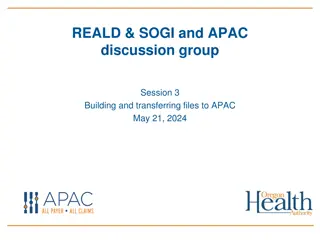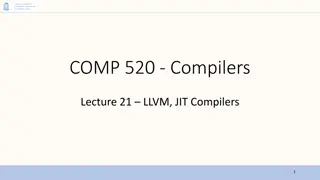
Consumer Inattention to Package Content: Effects of Downsizing Strategy on Pepper Market Shares
Explore the impact of consumer attention on downsizing strategies in the pepper market, focusing on how inattention affects product shares and consumer welfare. The study shows that even attentive consumers are more sensitive to price changes than size decreases, indicating that downsizing can be an effective strategy. Overall, inattention leads to a slight reduction in consumer welfare, with markets experiencing varying degrees of harm. Policy implications and potential welfare losses due to banning downsizing are also discussed.
Download Presentation

Please find below an Image/Link to download the presentation.
The content on the website is provided AS IS for your information and personal use only. It may not be sold, licensed, or shared on other websites without obtaining consent from the author. If you encounter any issues during the download, it is possible that the publisher has removed the file from their server.
You are allowed to download the files provided on this website for personal or commercial use, subject to the condition that they are used lawfully. All files are the property of their respective owners.
The content on the website is provided AS IS for your information and personal use only. It may not be sold, licensed, or shared on other websites without obtaining consent from the author.
E N D
Presentation Transcript
Discussion on the paper Does Peter Piper Pick Pepper Inattentively? Consumer Inattention to Package Content by Ian Meeker & Jakob von Ditfurth (2024) Dr. Fernando Herrera Gonz lez (Telef nica, UPM) CRESSE -2024 (Platanias, Greece)
Summary of Paper Reaction of consumers to downsizing by producers. Focus on inattention. Use case: downsizing event on pepper carried out by McGormick in 2019 Assumption: When consumers are inattentive, product shares will remain constant as consumers do not notice the change, whereas when consumers are attentive, the product shares decline according to consumers weight preferences. Model: estimate of utility conditional on inattention ( , Bernoulli distribution). Then market shares and total demand. Use of the BLP Method. Some results: Average own-price elasticity is 6.58, whereas the own-net weight elasticity is 2.03. So, even if consumers were fully attentive, they would be more than three times more sensitive to a price increase than to a size decrease. As a result, downsizing can be an effective strategy even when consumers are attentive. We find that inattention reduces consumer welfare by a small amount in absolute terms for most consumers. The welfare loss ranges from around $0.00 to $0.69, and the average loss is $0.012. Clearly, there are markets where the harm is quite large. The changes in market shares translate to a consumer welfare reduction of 2.7%. Moreover, the downsizing practice overall has a similar effect on consumer welfare. We study the policy of banning downsizing and estimate a 2.4% welfare loss due to the practice of downsizing.
Discussion (I) General comments: Nice paper, well written and interesting. Blending of psychological and economical issues Relevance of the topic in such a confusing world as Internet In the tradition on what Coase demanded from economists in his Proposal for research : We know very little about the cost of conducting transactions on the market or what they depend on ; we know next to nothing about the effects on costs of different groupings of activities within firms Assuming an exogenous increase in production costs, assess scientifically the best course of action for producers: Maintain size increasing price vs. Reduce size maintaining price Pepper specific features as retail product: Low frequency of purchases: While most consumers will purchase pepper at some point, they do so infrequently. In any given year, only around 40% of consumers buy pepper. Many go over a year before purchasing pepper again. Small share in the consumer basket: This abstraction is reasonable as consumers select a retailer based on a basket of products rather just than pepper ( ). As a result, pepper prices are likely not an important determinant of retailer choice.
Discussion (II) What is the cost of attention? Does it compensate the possible profits in a product with the features stated by the authors? Our results suggest that policies aimed at decreasing inattention to downsizing, like a proposed French law requiring food retailers to notify consumers of downsizing (Rajbhandari and Adghirni, 2023), or policies aimed at banning downsizing, will have benefits provided they are enforceable. What would be the cost of implementing this regulation? And of enforcing it? Recall: The welfare loss ranges from around $0.00 to $0.69, and the average loss is $0.012 (per year! GDP/Capita 77.000) Suggestions for improvement: Distinguish clearly price of packaged product vs. unitary price of pepper Explain why BLP is used as opposed to other methods Provide more guidance to the reader about how the results of the model translate into the stated consequences. Experimental economics (Vernon L. Smith, Bargaining and Market Behavior,) Maybe use peppers (the green) instead pepper (the spice) for a future study? With the bonus that the title will fit better with the tongue-twister of the title Peter Piper picked a peck of pickled peppers













